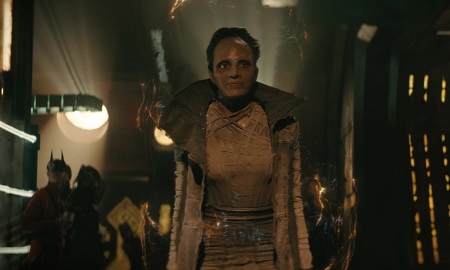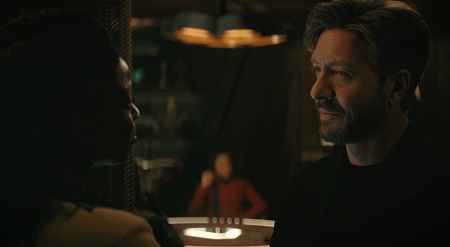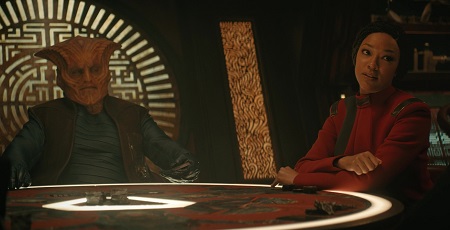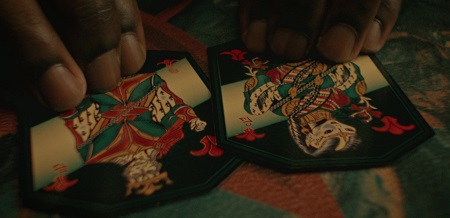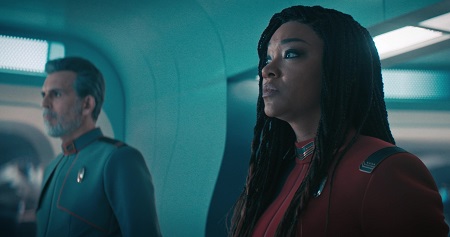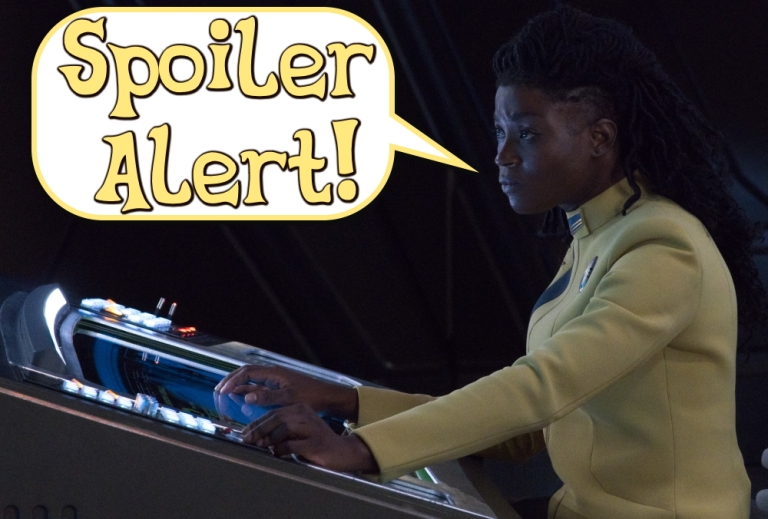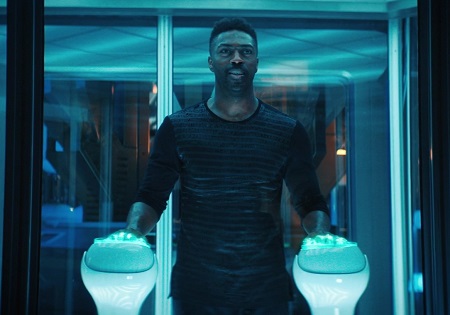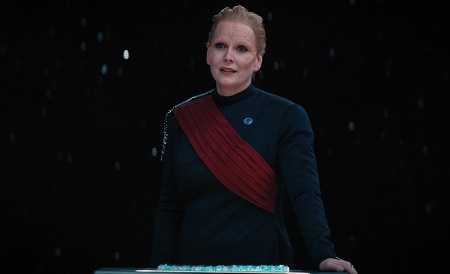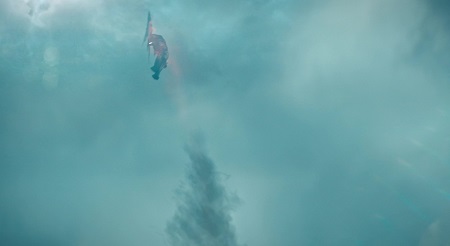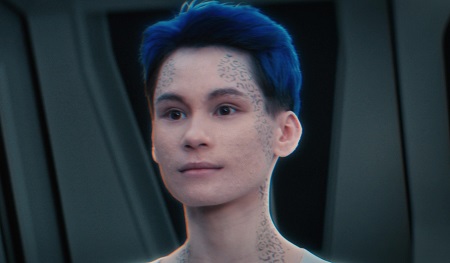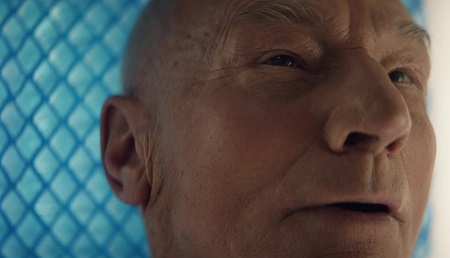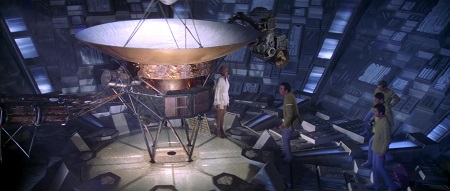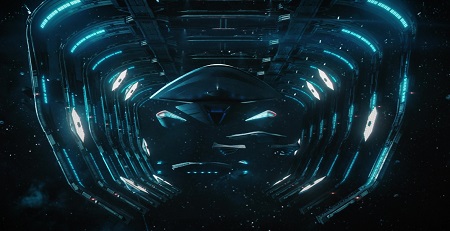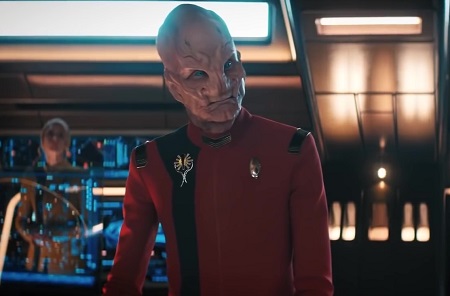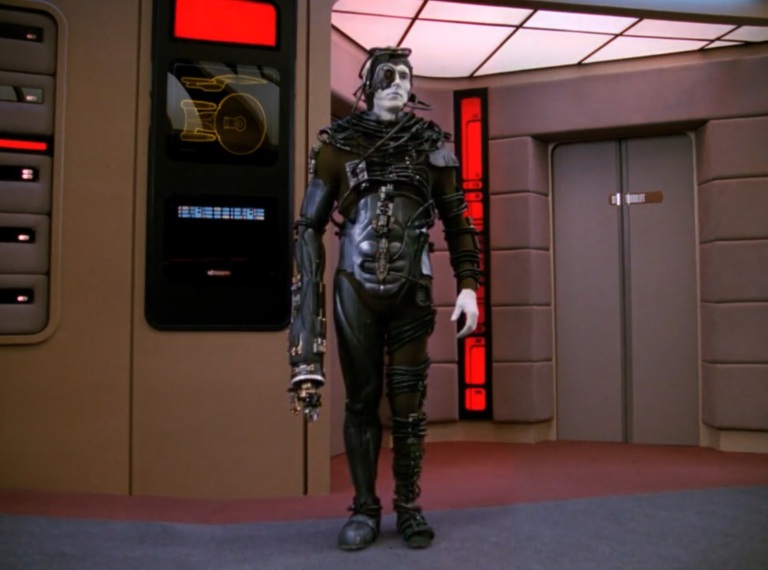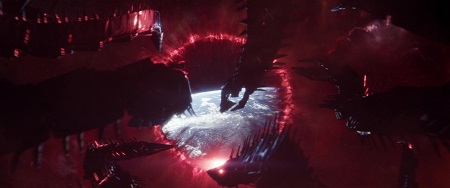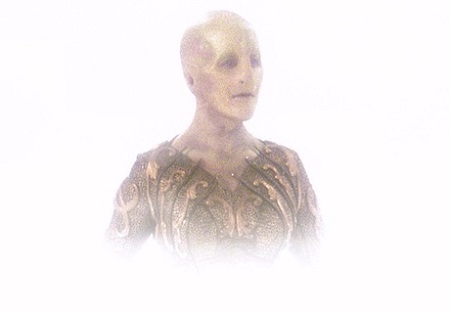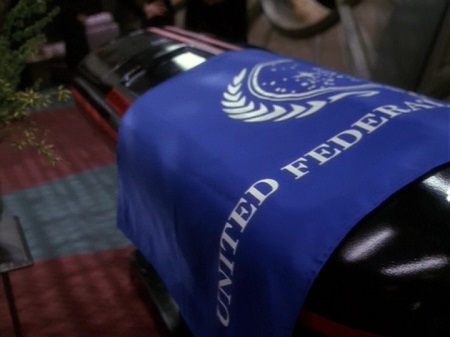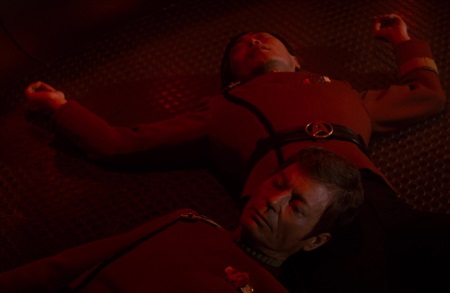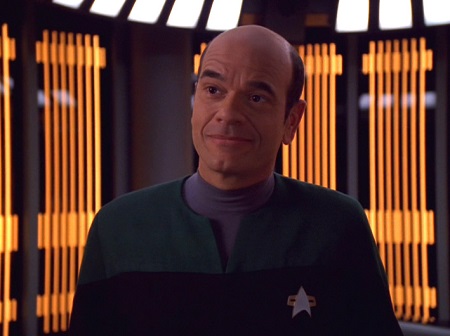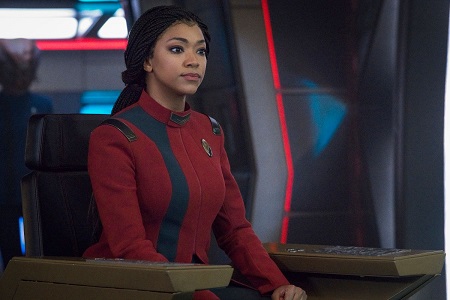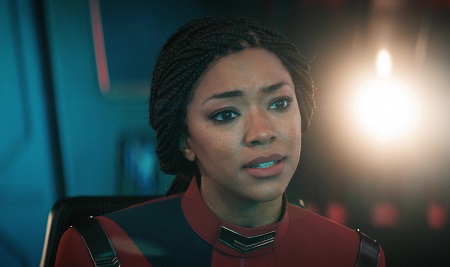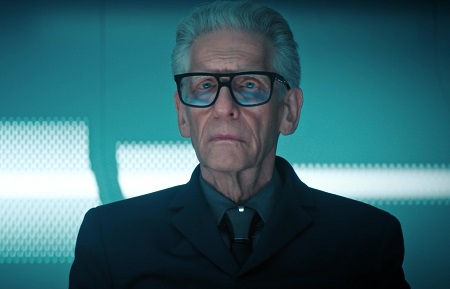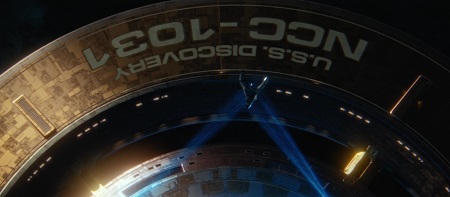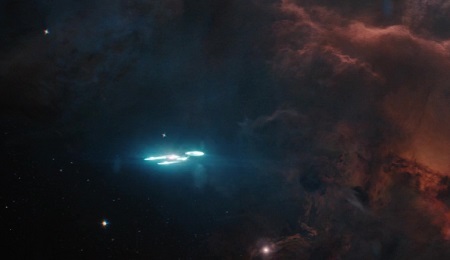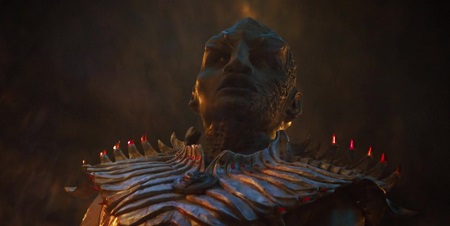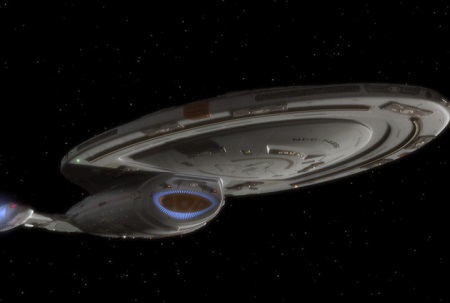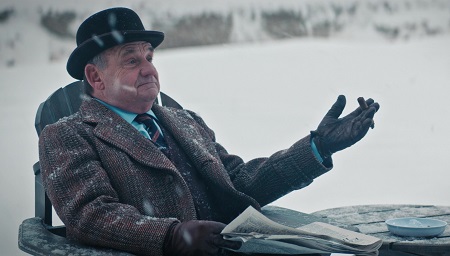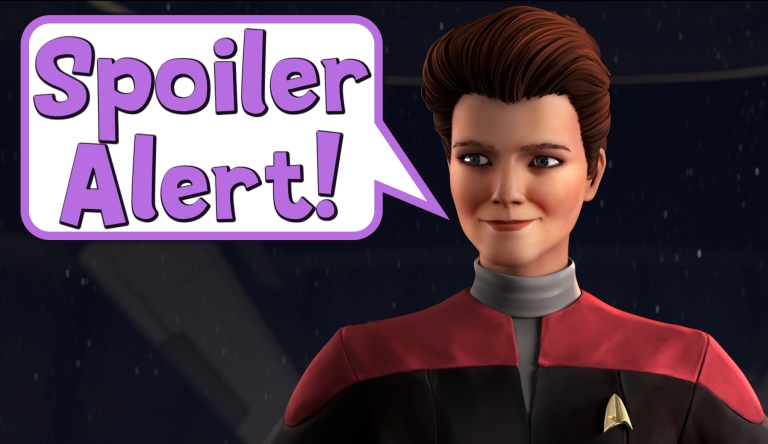
Spoiler Warning: There are spoilers ahead for Star Trek: Discovery Seasons 1-4, Star Trek: Picard Season 1, and for other iterations of the Star Trek franchise.
After an unexpected sabbatical, Discovery Season 4 returned with the episode All In. If you read my review of the episode, you’ll know that I didn’t think it was the strongest one of the season so far, but it was interesting in some ways and certainly contained some excellent performances from all of its leading stars. Because All In was, in large part, a detour as Book, Burnham, Owosekun, and Tarka scrambled to get their paws on a magical macguffin molecule called isolynium, most of our big ongoing theories didn’t see significant movement this week. That said, there’s still a lot to talk about and a few updates to get through!
There are still some big open questions, and with five episodes left I’m expecting at least some of them to start moving in pretty big ways in the next week or two! For me, the biggest point of interest right now is whether the season’s big stories will connect in a major way with past iterations of Star Trek. There are a few different ways this could happen, but a big part of me suspects that, as with the Burn in Season 3, we’re going to get something altogether new.
This week we have one confirmed theory and one theory on the production side of things that I’m very pleased to see has been debunked! As always, we’ll start there before moving into the main theory list.
Confirmed theory:
The DMA isn’t a super-weapon.
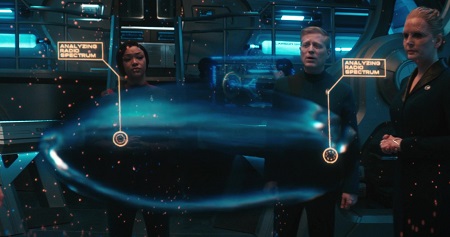
Although I felt that the sequence which contained this revelation was cut rather short, Captain Burnham, Stamets, Zora, and Saru managed to figure out between them what the DMA’s true purpose is. Rather than being a super-weapon, as had been originally assumed, the DMA is a glorified piece of mining equipment, or as Captain Burnham put it, a dredge.
Its purpose appears to be to scour the galaxy for the rare isotope boronite – something that was first mentioned in the Voyager Season 4 episode The Omega Directive. Boronite can be used to synthesise omega molecules – one of the most powerful substances in the known galaxy – but Unknown Species 10-C appear to be using it to power their hyperfield – a kind of forcefield or cloak which is concealing their base or star system.
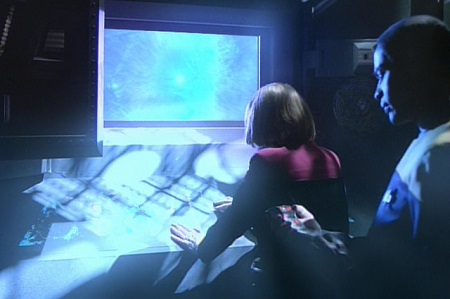
I really like this angle. If the DMA isn’t a natural phenomenon, which it seemed to be at first, then having it be something other than a weapon adds a different dimension to the story, one which takes it away from being a fairly typical conflict into something more complex – and, I would argue, more “Star Trek.” We’ve talked about the “it was only trying to communicate!” trope in relation to the DMA before, and how misunderstandings have long been part of Star Trek’s storytelling tradition, highlighting the complexities of dealing with very different cultures and the dangers of making assumptions. This side of the story seems to be cut from the same cloth.
This also seems to rule out other theories about the DMA, such as it being an experiment gone wrong. There’s still room for further twists and turns in the DMA’s story, though, so let’s wait and see what happens, and just what purpose Unknown Species 10-C has in mind for all of this boronite!
Debunked theory:
Star Trek: Discovery isn’t going to be renewed for a fifth season.

Phew! I was getting genuinely worried when we passed the season’s halfway point with no indication of a Season 5 renewal. In past years, we’d always known either before the season kicked off or within a week or two of its premiere that the show had been renewed, so when we got further and further in with no official news – and no rumours of production starting quietly – I began to get worried for Discovery’s future.
But in January, while the show was on hiatus, ViacomCBS confirmed that Discovery will indeed get a fifth season – making it the first show since Voyager to make it that far! (Sorry, Enterprise) This is great news, because I’m not ready yet to say goodbye to Captain Burnham and the crew. There’s so much scope for more adventures in the 32nd Century, and I feel like Discovery could continue to expand and explore this setting, perhaps laying the groundwork for more 32nd Century shows.
So those theories were confirmed and debunked.
Now we can jump into the main theory list! As always, we’ll begin with those theories that are either new or that saw significant movement in All In, before rounding out the list by recapping the rest of them.
Theory #1:
Tarka will realise that there’s a tracker on the isolynium.
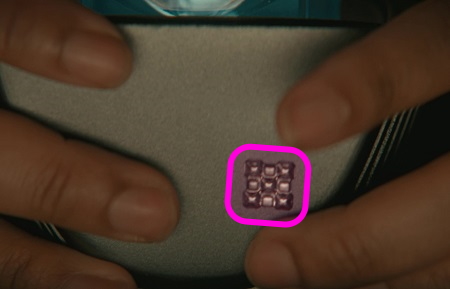
Tarka is sharp, and more than that he has access to – and the ability to build – clever pieces of tech. We saw this week that he was able to create a changeling-capturing machine out of a low-quality Devore scanner. It stands to reason he’d want to scan the isolynium that Book procured, and if he’s as thorough as we’ve seen him be so far, perhaps he’ll figure out that Captain Burnham placed a tracking device on it.
If so, the signal that Captain Burnham showed off at the end of All In may lead to a dead-end! I’m sure that the USS Discovery will catch up with Tarka and Book – if not, the story would be fairly short and boring, after all – but it may not be as simple as following the map to the cleverly-placed tracking device.
Theory #2:
Tarka’s weapon will be successful.
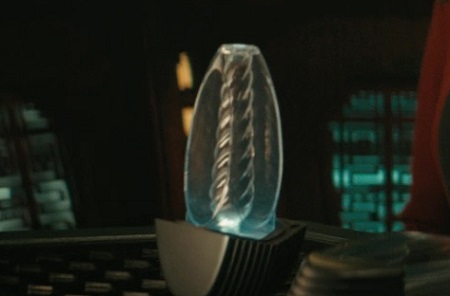
President Rillak has tasked Admiral Vance and Captain Burnham with stopping Book and Tarka before they finish work on their weapon and use it against the DMA, fearing that destroying the DMA will lead to all-out war with Unknown Species 10-C. The obvious story route from here is that Captain Burnham and the crew will track them down and either talk them out of it or destroy the weapon before it can be used. But that may not be the direction that Discovery plans on taking us.
It could be more interesting in some ways if Tarka and Book succeed in their aim of launching and detonating the weapon, destroying the DMA and attracting the attention of Unknown Species 10-C. Such a highly advanced species – if they’re as advanced as everyone is assuming, anyway – would be a formidable opponent, but they could also be willing to listen to diplomatic overtures. Perhaps Tarka and Book would have to be sacrificed, imprisoned with Unknown Species 10-C as punishment for their crime.
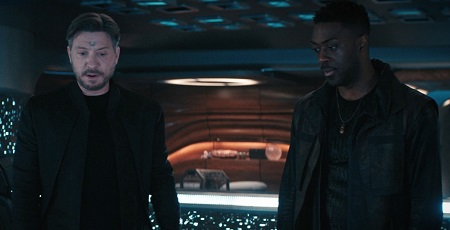
Speaking of diplomacy, in the mad rush to stop Book and Tarka, I certainly hope that President Rillak hasn’t forgotten about trying to contact Unknown Species 10-C. At the very least, now the Federation knows where they are they should send a message warning them of Book and Tarka’s intentions. It might have to be more of a rush job that the Federation would have preferred – but it would be better to at least make an attempt at first contact in case Captain Burnham can’t stop the weapon in time.
Discovery is definitely unpredictable right now, and I could easily see the series taking its main story to unexpected places. Book and Tarka successfully deploying their weapon would be just one example, and it could make the introduction of Unknown Species 10-C all the more intense, exciting, and edge-of-your-seat thrilling.
Theory #3:
Unknown Species 10-C is extinct.
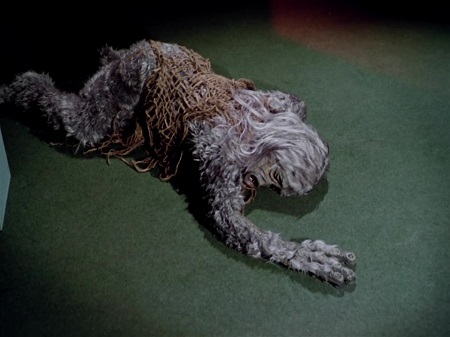
We’ll talk in a moment about what All In might mean for my Unknown Species 10-C suspects! But there’s one possibility that I hadn’t really given much thought to that suddenly came to the fore in light of the fact that Unknown Species 10-C is still a mystery and, more significantly, that Starfleet has no way of scanning their base/star system. What if Unknown Species 10-C has already gone extinct?
Perhaps they went extinct recently, or perhaps it was millennia ago. The DMA might be Discovery’s equivalent of the Planet Killer from The Doomsday Machine; an automated device left behind, a warning to the real world about the dangers of some of our long-lasting environmental and technological impacts.
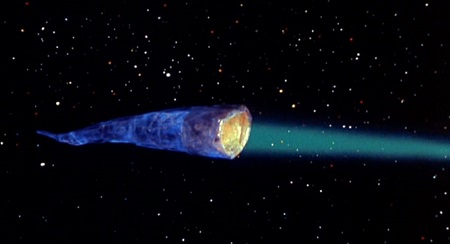
The DMA could even be Unknown Species 10-C’s last-ditch effort to prevent their own extinction. Having used up their entire power supply, they had to build such an imprecise, devastating machine to harvest all of the boronite they could possibly find just to keep the lights on and their machines powered. There could be an interesting analogy there, too.
Because Unknown Species 10-C remains hidden from us going into the next episode, all sorts of possibilities remain on the table. This could certainly be a different and unexpected way to take the story, and perhaps the culmination of the plot would be more of a technological puzzle than a conflict against an adversary, with Captain Burnham leading Starfleet’s efforts to figure out Unknown Species 10-C’s technology in order to deactivate the DMA.
Theory #4:
Nhan works for Section 31.

Spoiler warning for the next episode, Rubicon, but Nhan will be making a return to Discovery! I thought it was unfortunate that she was shuffled off the ship at such an early stage in Season 3; there was scope, I felt, for more Nhan stories. So it’ll be great to welcome her back to the show in just a few days’ time!
One thing struck me about Nhan based on a couple of photos that the official Star Trek social media channels released, and that’s her uniform. Nhan isn’t kitted out in the standard Season 4 Starfleet uniform that the rest of the crew wear. Hers appears to be a new variant, possibly in a similar style to Lieutenant Willa’s from Season 3. There are many possible explanations for Nhan’s uniform, including an assignment at Federation HQ or a continuation of her service aboard the USS Tikhov, but one interesting possibility comes from Nhan’s background as a security officer. Maybe she’s been recruited by the 32nd Century equivalent of Section 31.
Theory #5:
Tarka’s mysterious “friend” is someone we’re already acquainted with.
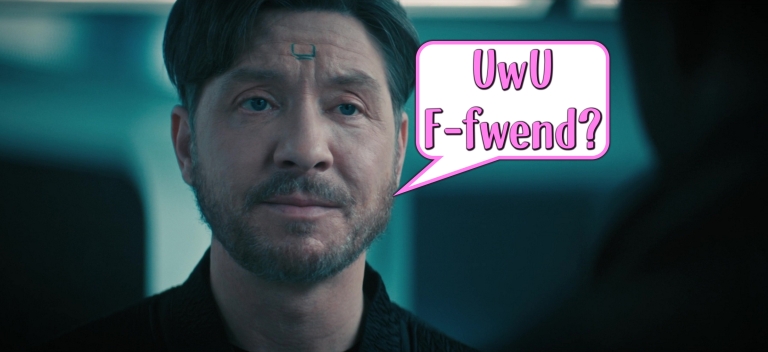
All In saw a brief conversation between Tarka and Owosekun in which the subject of his mysterious friend came up. There seems to be more going on with this character than meets the eye, though whether Tarka was being genuine in his emotional reaction isn’t 100% clear! It’s a distinct possibility that his friend is, in fact, a love interest or even a spouse, and that could certainly be an interesting development.
The fact that Discovery has gone out of its way to keep this character’s identity a mystery is interesting as well, and one reason for doing so could be that Tarka’s friend is someone who we as the audience have already met. If it wasn’t a big deal, why not just have Tarka say the individual’s name? The more appearances Tarka makes without revealing this character’s identity, the more strongly I feel that it will turn out to be someone we’ve already met.
I put together a short list of possible candidates for being Tarka’s mysterious friend, and you can find it by clicking or tapping here.
Theory #6:
Book and Burnham will get back together.
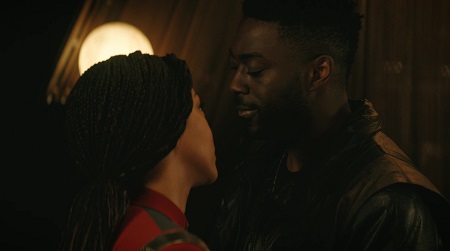
I have to be honest: I’m not interested in more Burnham Relationship Drama™. Discovery has already done this with Ash Tyler in Seasons 1-2, and it was okay then, but it’s overdone by now. I get where the central conflict with Book has come from, but I don’t feel that the show needs this additional injection of drama to make Season 4’s story work. If I were to cut one aspect of the Season 4 story that we’ve seen so far, it would be this.
So with that in mind, my hope is that the Book-Burnham feud will be brought to an end – and hopefully within the next couple of episodes. Ideally I’d like to see them get back together, although some of the things they said to each other in All In might make that more complicated. If Burnham manages to stop Book and Tarka, perhaps he’ll come around to her way of thinking. If they’re successful in using the weapon, the argument they had will become a moot point. So there are different ways this could go, but I’m hopeful that it will be resolved soon as it’s an aspect of the show that I’m really not wild about.
Theory #7:
The DMA is a life-form.
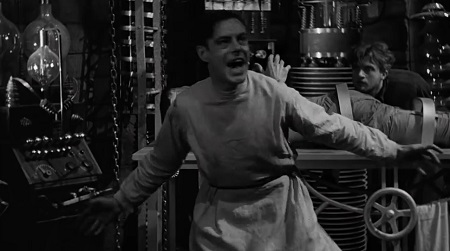
Frankenstein (1932)
The revelation that the DMA is a mining tool or dredge would seem to make this theory a lot less likely – but I’m not yet willing to strike it from the list. There are several ways it could unfold, but one possibility is that the DMA is a self-aware piece of technology, comparable to Zora. Perhaps it’s carrying out its orders, unaware of the damage it’s doing, and will be able to be reasoned with even if Unknown Species 10-C won’t back down.
Or perhaps the DMA has gone rogue, operating without Unknown Species 10-C’s permission. That would also be an interesting angle, as it could mean that Captain Burnham and Starfleet will have to ally with Unknown Species 10-C to stop the DMA. Some aspects of this theory as I originally formulated it – such as coming to an understanding with the DMA in a story comparable to V’Ger’s in The Motion Picture – seem to be off the table entirely. But the DMA being a self-aware, conscious machine isn’t… at least, not yet!
Theory #8:
Unknown Species 10-C is a faction from a past iteration of Star Trek.

The revelation of the hyperfield at Unknown Species 10-C’s point of origin was an interesting one. A field that size could conceal a small star system, as Admiral Vance suggested. But it could also hide something like a huge fleet of starships – or giant mechanical aliens. In my view, there are only a few likely candidates remaining from the long list I put together before Christmas. The technology required to create the DMA and the hyperfield seem to rule out factions like the Klingons, the Gorn, and others.
But there are still some known Star Trek factions with the potential capability of building something like this. I would point to the Borg, the super-synths from Picard Season 1, Enterprise’s Sphere-Builders, the Kelvan Empire from The Original Series (who are also an extragalactic faction), and possibly others like Species 8472, V’Ger, the Q Continuum, or the Terran Empire.
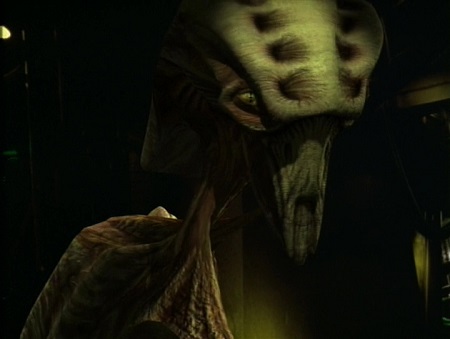
I confess that I feel a sense of déjà vu right now. In Season 3, I theorised and speculated about possible culprits behind the Burn, and a lot of the same names and factions were in the frame then, just as they are now. The Burn ultimately went in a very different and unpredictable direction, and I feel that Unknown Species 10-C could end up in a similar place as a brand-new faction altogether. Because of the mysterious nature of the story, and how long it’s been rumbling on, would that feel like an anticlimax? If Discovery encouraged fans to guess and speculate about who Unknown Species 10-C are, would it be disappointing if the answer was “someone new that you could never have guessed?” I can’t shake the feeling that it might be.
For a more detailed look at the suspects mentioned above, as well as a few less-likely contenders, check out my full list by clicking or tapping here.
Theory #9:
President Rillak knows what the DMA is and may be implicated in its creation.

I will admit that, as things stand at the end of All In, President Rillak is looking less and less likely to be involved directly with Unknown Species 10-C and the DMA. But there’s still time for a connection to be revealed!
In short, President Rillak’s single-minded goal of reuniting the Federation may be well-served by providing the disparate members with an enemy or a problem to unite against. The DMA has already accelerated Ni’Var’s membership, and President Rillak even got to speak with a representative from Earth – so if she is involved somehow, her scheme is already paying dividends. At the very least, I think it’s fair to say that this complex, somewhat Machiavellian character is not letting the crisis go to waste, and is politicking off the DMA’s trail of destruction.

In her dealings with Captain Burnham, I’d argue we’ve seen this Machiavellian edge to President Rillak. In the Ni’Var negotiations depicted in All Is Possible, and again for a second time in But To Connect, President Rillak used Captain Burnham to advocate positions that would’ve been politically or diplomatically difficult for her to do openly – effectively manipulating those events from behind the scenes.
In light of all of this, I would hope that Captain Burnham will tread carefully with President Rillak. She seems the type who would happily throw Burnham and the USS Discovery under the bus if it suited her political and/or diplomatic ends. If someone like that felt that unleashing the DMA, or failing to warn everyone that it was coming, would be to her advantage, I can absolutely see her seizing on that opportunity, too. There are myriad ways in which we could connect her to the DMA, even if she didn’t order its creation. She could be in cahoots with Unknown Species 10-C, she could have learned about the DMA and chosen to cover it up, or something else that she believed was in the Federation’s long-term interests.
Theory #10:
Michael Burnham won’t remain captain of the USS Discovery.
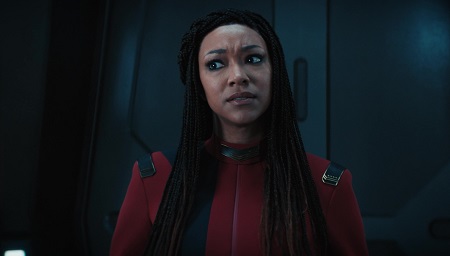
One of the unique aspects of Discovery within Star Trek’s broader canon is that the ship has been commanded by four very different individuals across its four seasons. Captain Burnham is different from Saru, Saru was different from Pike, and Pike, in turn, was different from Lorca. It has to be considered at least a possibility – albeit a remote one, perhaps – that the series will continue this trend.
Now that we know that Season 5 is definitely happening, one possibility is that Captain Burnham will somehow leave the ship at or around the end of Season 4, making way for a brand-new commanding officer to take over. Because she’s been the show’s protagonist since Season 1, it seems unlikely, and the overall arc of Discovery between Season 1 and Season 3 can be read as Burnham’s redemption and ascent to the captaincy. But the show’s revolving door of captains may continue.
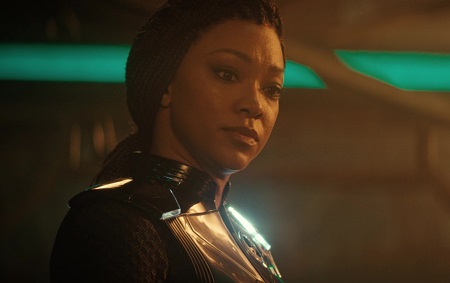
I’m not really in favour of this, but it’s certainly interesting to consider. The episodes But To Connect and All In definitely showed us how conflicted Burnham feels with regards to Book; she’s torn between her duty and the person she loves. Maybe she will have the strength to do what she believes is right during the DMA crisis, but will resign afterwards, unable to contemplate doing the same thing again and wanting to return to her simpler life with Book. This wouldn’t be a bolt from the blue, as we saw her wrangling with these feelings in Season 3.
Alternatively, Burnham could be promoted, taking up a senior role within Starfleet either at Federation HQ or on a new flagship. We already know that she had been in the running for the captaincy of the USS Voyager-J, so maybe she’ll convince President Rillak, through her work on the DMA, to reconsider her for that role. In short, there are ways her departure could be handled in a way that would feel natural – just like Tilly’s departure did earlier in the season.
Theory #11:
The Guardian of Forever will be back.
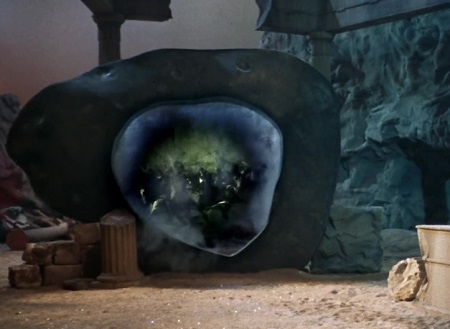
I’m close to retiring this theory. In short, I had suggested that the reintroduction of the Guardian of Forever in Season 3 could mean that we’ll encounter the timeless entity again in Season 4. It would be nice to bring back Paul Guilfoyle, who played the Guardian’s humanoid avatar in the Season 3 two-parter Terra Firma.
However, it seems as though the DMA/Unknown Species 10-C story isn’t going in that direction. It would make sense, in a way, for Captain Burnham to seek out the Guardian to ask it about the DMA and Unknown Species 10-C – it may well know something about what’s going on that could be helpful. But the best time to have done that would have been earlier in the season. There are still ways in which the Guardian of Forever could be included, though, so although I’m close, I’m not dropping it just yet.
Theory #12:
Tarka will create his own DMA.

In The Examples, Tarka – aided by Stamets – created a working replica of the DMA, albeit on a smaller scale. According to Reno, this recreation came very close to destroying the entire ship! Now that Tarka has isolynium, could it be possible that he will create the DMA – either intentionally or accidentally?
Because of the DMA’s wormhole technology, it doesn’t seem like too much of a stretch to think it could travel through time as well as space, meaning a possible time-loop story is on the cards. It’s got to be at least possible to think that throwing a massive bomb at the DMA could have unintended consequences – if, that is, Tarka actually intends to build a bomb! He might see the DMA’s technology and seek to replicate it, creating his own DMA as a means to break through into the parallel universe he’s aiming to reach.
Theory #13:
Tarka’s “friend” is directly involved with the DMA.
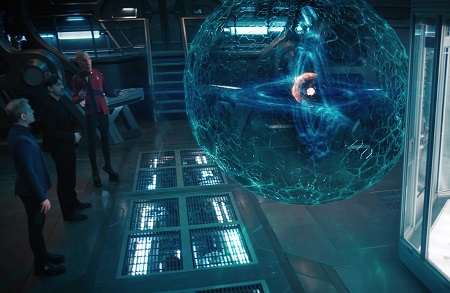
Though we didn’t learn a lot more about Tarka’s friend in All In, from what we do know about them – their scientific background and desire to travel to an alternate reality – they could be a candidate for building the DMA. Unknown Species 10-C could, perhaps, be a single person, or Tarka’s friend could have worked with them, trading their scientific knowledge for Unknown Species 10-C’s power-generating technology.
Like with President Rillak, there are different ways this involvement could work, and different degrees to which Tarka’s friend could be implicated. But one thing is clear: Tarka knows a lot about the DMA, probably more than he’s been willing to share. That knowledge has to have come from somewhere, right? Maybe his friend told him about this technology before they got separated.
Theory #14:
Book will find Kyheem and Leto on the other side of the DMA.
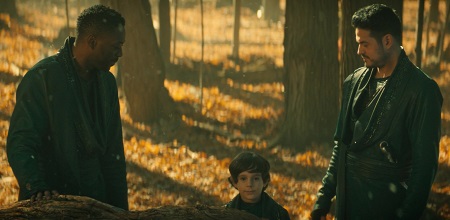
In Star Trek: Generations, Captain Picard encountered Captain Kirk inside the Nexus – despite Kirk being declared “dead” after the Enterprise-B encountered the energy ribbon almost eighty years earlier. Now that we know a little more about how the DMA operates, it seems at least faintly possible that, just like Captain Kirk, the inhabitants of Kwejian may not be as dead as they first appear.
This theory is, I freely admit, a bit of a long-shot. But the wormhole technology that we know the DMA uses seems to be capable of sending some of what it harvests or mines back to Unknown Species 10-C’s base of operations. Maybe that means that some of the people from Kwejian were transported there instead of being killed.
So those theories are new or saw movement this week.
Now we’ll recap all of the other theories currently in play! It helps to keep the list complete and in one place, so that we can update and cross off theories as we go!
Theory #15:
Tarka aims to travel to the Kelvin universe.

There are many parallel universes, as Tarka reminded us in But To Connect. Though Star Trek has shown us a number of different parallel universes before, the biggest one that comes to mind (aside from the Mirror Universe) is the Kelvin timeline, in which the three reboot films were set.
A fourth Kelvin film may or may not be happening, but even if it does the setting remains ripe for further exploration. We don’t know how far the Kelvin timeline and the prime timeline will have diverged, and whether it operates like the Mirror Universe with every character getting their own alternate counterpart. If it does, perhaps Tarka met his own Kelvin timeline counterpart and that’s how he cooked up this scheme. If the Kelvin timeline diverged significantly from the prime timeline it stands to reason that the Burn never happened there. We also got an oblique Kelvin timeline reference in Season 3 – could that have been a hint?
Theory #16:
Some areas of the galaxy – such as the Delta Quadrant – avoided the worst effects of the Burn.

In But To Connect, President Rillak told us that the diplomatic summit she convened would bring together races from “all four” quadrants. Assuming she was referring to the familiar Alpha, Beta, Gamma, and Delta Quadrants that make up the Milky Way galaxy, this would count as our first mention of the Delta Quadrant in the 32nd Century. I didn’t spot any familiar Delta Quadrant races (or their emblems) amongst the assembled delegates, however!
I had previously speculated that the Burn may not have affected the entire galaxy equally, and that regions farthest away from the Verubin Nebula may have survived without much damage. I still think that this is a possibility – though whether Discovery will revisit the Burn in any depth, or visit the Delta Quadrant at all, remains unclear.
To see a full write-up of this theory, click or tap here.
Theory #17:
There will be a character crossover from a past iteration of Star Trek.
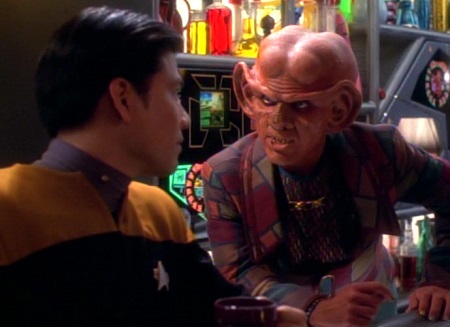
Tarka’s friend could, as mentioned, be someone we’ve already met. But there are other ways to bring back a character from a past iteration of the franchise – and there would be many potential benefits to doing so! I had initially proposed a version of this theory in the run-up to Season 3 that centred on the Doctor from Voyager – but with some creative technobabble, practically anyone could be included, despite the leap forward in time.
Choose To Live showed us the Abronians in cryo-sleep, and Stormy Weather saw the crew of Discovery use the transporter buffer to survive – just like Scotty had done in The Next Generation Season 6 episode Relics. Could these be hints at something to come?
It would also be possible for Captain Burnham to discover the logs or a holographic recording of a long-dead character – and while this would be less of a “crossover,” it could still be a ton of fun and great fan-service!
Theory #18:
Season 4 will connect with the Short Treks episode Calypso.
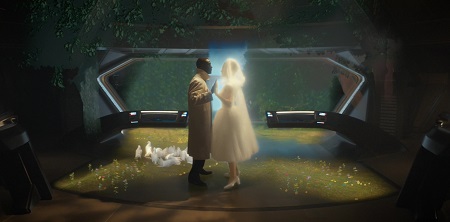
Zora’s status as a member of the crew was confirmed in But To Connect, and this followed her developing emotions and sentience earlier in the season. Zora is now much closer to her presentation in Calypso, potentially bringing the story of the Short Treks episode one step closer.
There are still significant hurdles to overcome if the story of Calypso is to be wrapped up in Season 4, though. Obviously we have the timeframe issue: will the USS Discovery be sent back in time, be abandoned, or is Calypso taking place centuries in the future? Then we have the USS Discovery itself – it’s been retrofitted since arriving in the 32nd Century, and now looks very different to how it did in Calypso. I’m not sure how Discovery will overcome these hurdles – but it’s possible. It feels like a proper link-up with Calypso is edging closer week by week.
Theory #19:
A major character will be killed off.
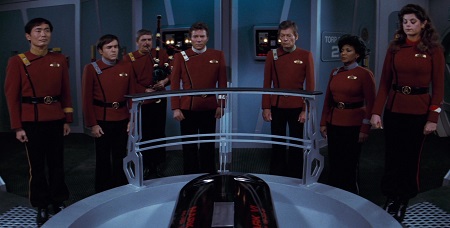
Lieutenant Tilly’s departure in All Is Possible definitely shook up the cast. And Gray’s departure in But To Connect may do so as well. However, I stand by what I said before the season aired: killing off a character can be a great way to demonstrate the dangerous nature of the circumstances that the crew have found themselves in. So far, despite tangling with the DMA on several occasions, only a couple of redshirts have lost their lives.
In Stormy Weather, Dr Pollard raced through the corridors of the USS Discovery to reach a hull breach. Shortly after she arrived, a redshirt was blown out into space – but Dr Pollard survived. Although moments like this can make it feel that Discovery is shielding its main and secondary characters with some pretty heavy plot armour, I still feel that there’s scope to see a major character death before the season ends.
If you want to check out my pre-season “death predictions,” in which I speculated about which characters may or may not be in danger, you can find that by clicking or tapping here.
Theory #20:
The crew will have to defend the Verubin Nebula.
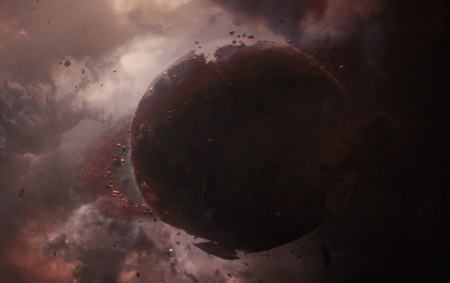
Despite having grown to sixty member worlds, the Federation is still in a weakened state and isn’t yet back to full strength. The Verubin Nebula is thus a very tempting target for anyone looking to gain an edge in a galaxy where dilithium is still in short supply. As the only known significant cache of the valuable fuel, whoever controls the Verubin Nebula will have a massive tactical advantage.
It would begin to stretch credulity to think that everyone in the known galaxy would see the Federation rebuilding and having access to dilithium and not want to find out for themselves what’s going on. Once the Verubin Nebula’s existence becomes known, even if the Federation promises to share its bounty with all comers, it seems very likely that someone would want to take control of the dilithium supply for themselves.
Theory #21:
The ban on time travel will be explained in more detail.

This one is as much a hope as a theory right now! In short, the ban on time travel was introduced early in Season 3 primarily as a way for the writers and producers to avoid questions about why the 32nd Century was so different from how the far future had been depicted in earlier Star Trek productions, as well as to explain things like how the Burn was able to catch the Federation off-guard and why Georgiou couldn’t simply be sent back in time when she needed to.
But the ban itself raises some issues – the biggest one being the lack of detail on how it works and how something like this could possibly be enforced. As I said several times last season, it isn’t possible to just un-invent a technology so useful and powerful as time travel. Even just a few lines of dialogue going into a little more detail on the mechanisms involved in the ban would be really useful.
Theory #22:
The Federation has flouted the ban on time travel.
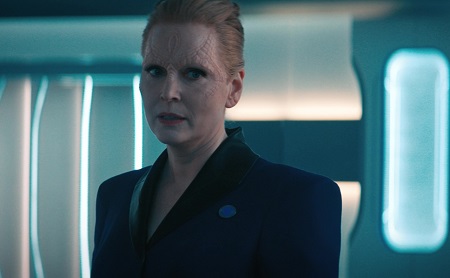
Sticking with the time travel ban, another theory I had last season was that the Federation – and Section 31 in particular – might have deliberately flouted the ban and failed to abide by the rules. Someone as straight-laced and committed to Starfleet ideals as Admiral Vance is highly unlikely to have sanctioned such a move, but there are other Federation leaders – such as President Rillak – who could be implicated.
I don’t think it’s possible any more that the DMA story will be connected to the time travel ban, as I had previously proposed. But that doesn’t mean that a closer look at the ban, and the potential for the Federation to have tried to work around it, isn’t going to happen.
Theory #23:
Saru will be given the captaincy of the USS Voyager-J.
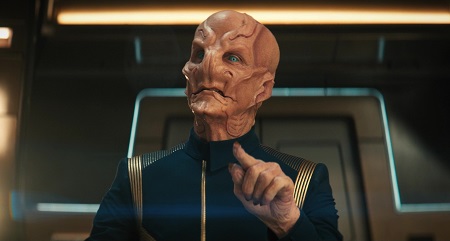
Saru’s future was briefly discussed before he offered to serve as Captain Burnham’s first officer in the episode Anomaly. He has already been offered a command of his own, so Starfleet clearly values his command abilities and experience. President Rillak was seen to be assessing Captain Burnham’s suitability for the captaincy of the USS Voyager-J in Kobayashi Maru… and she mentioned having a shortlist of candidates. Could Saru be on her list?
Several of the qualities that President Rillak said she was looking for in a potential captain seem to apply to Saru. He’s more level-headed, less likely to put himself in a dangerous situation, and more inclined to think of the big picture. He has a weakness when it comes to Kaminar, as we saw toward the end of Season 3, but generally speaking he isn’t someone who lets his emotions get the better of him. His wisdom and calm demeanour could be valuable in the captain’s chair of the Federation flagship. This could also set the stage for his departure from the show, or possibly even for a new show following his adventures aboard his new ship.
Theory #24:
The Red Angel suits from Season 2 are connected to the DMA.
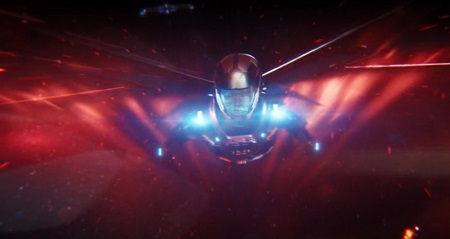
Unknown Species 10-C seem to be responsible for building the DMA. But it isn’t the first wormhole-creating technology that Discovery has introduced us to! The Red Angel suits in Season 2 were also capable of creating powerful wormholes… so could it be possible that Unknown Species 10-C built their device around or based on the same technology?
This revelation would greatly affect Captain Burnham, as she’d feel a degree of responsibility even though she wasn’t directly involved. It would also be the second disaster in a row (following the Burn) in which the Federation was implicated – albeit in an oblique way. I’m not convinced that Discovery will go down this route… but the similarities in the wormhole-creating technology gives me pause, at least.
Theory #25:
We haven’t seen the last of the Abronians.
I currently have four ideas for different ways that the Abronians – the non-humanoid race that Captain Burnham, Tilly, and the Qowat Milat helped save from cryo-sleep in the episode Choose To Live – could play a further role in Season 4.
Theory #25 A:
The Abronians’ homeworld was destroyed by the DMA.
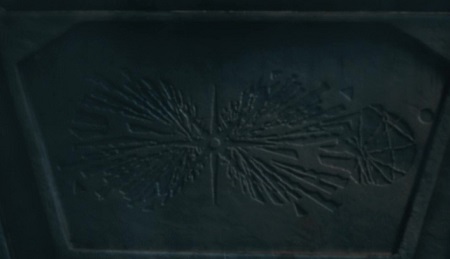
After arriving at the Abronians’ cryo-ship, Captain Burnham found a stone carving that seemed to depict the destruction of the Abronians’ homeworld. This carving was only shown on screen briefly, but it seemed to show the planet being damaged or destroyed in a large explosion. Burnham credited the planet’s destruction to a “supernova,” and the story then raced ahead.
Considering that the main thrust of the season so far has been about the DMA, perhaps Burnham was incorrect: the Abronian homeworld was destroyed by the anomaly, not a supernova.
Theory 25 B:
The Abronians’ homeworld was on the “other side” of the DMA.

Now that we know a little more about how the DMA works, this theory seems a little more plausible. Its powerful wormhole technology seems capable of transporting matter over many light-years, meaning it doesn’t seem to be a complete stretch to think that the Abronians may have originated in the vicinity of Unknown Species 10-C. They could even be Unknown Species 10-C!
One thing struck me as odd about the Abronians: the Federation was entirely unaware of them, despite the Abronian cryo-ship being relatively close to Federation space – such that Captain Burnham could reach it using Book’s ship in a short span of time. It’s possible that the Abronians had been asleep for millennia, unnoticed by the Federation and the wider galaxy for all that time. But it’s also at least possible that their cryo-ship is a newcomer to the area. If so, perhaps it arrived here via the DMA.
Theory #25 C:
The Abronians will return to help the Federation later in the season.
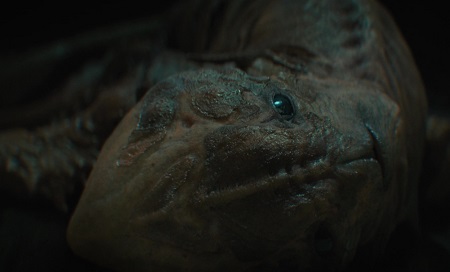
One of the themes of Discovery since Season 3 has been connection, including building connections between the Federation and other races and organisations. The Abronians were awoken from cryo-sleep thanks to the interventions of Captain Burnham and Tilly – at least in part – and they may seek to repay the Federation, or Captain Burnham personally, for that help.
We saw this play out last season with Ni’Var; in the season finale Ni’Var ships raced to the Federation’s aid as the Emerald Chain attacked. Perhaps the Abronians will likewise step up to help when the Federation needs allies.
Theory #25 D:
The Abronians’ moon-ship may be useful in a later story.

The Abronians’ cryo-ship is huge, and at least superficially seems to have the mass of a moon or small planetoid. If Captain Burnham and the crew needed a starship that large, such as to aid in the evacuation of a planet threatened by the DMA, for example, perhaps they’ll return to the Abronians and ask to borrow it.
As we saw in Choose To Live, the moon-ship was in full working order. All it needed was some extra dilithium to power up and it was perfectly capable of moving under its own power, and its computer systems were still functional. The only system that seemed to have failed was the wake-up timer! Discovery has precedent when it comes to telling seemingly one-off stories that have a pay-off later on, so watch this space. If Captain Burnham and the crew need a huge starship urgently, we may not have seen the last of the moon-ship!
So that’s the main theory list.
There is still one production-side theory in play, so we’ll recap that now before we wrap up.
Production-side theory:
Tilly’s departure will be permanent.

Mary Wiseman confirmed in an interview with Wil Wheaton on The Ready Room (Discovery’s social media aftershow) that Tilly will be seen again before the end of Season 4, and we glimpsed her in the trailer for the second half of the season as well. But that doesn’t mean she will return as a main character on the show going forward, and her departure in All Is Possible felt permanent. Despite that, I’ve seen quite a lot of folks online who don’t believe that Tilly is actually leaving the series – so I wanted to put it out there officially and say that, in my opinion anyway, she is.
Maybe those people know something that I don’t! As I always say, I don’t have any “insider information;” all of this is just speculation on my part. However, I feel that the manner of Tilly’s departure, the fact that she got that emotional sequence with Captain Burnham, a montage showing her leaving the ship, Adira seeming to take over several of her roles, and her departure feeling like the culmination of her arc going back to the latter part of Season 3 all come together to strongly indicate that she won’t be back as a major character. She may yet have a significant role to play in a future Season 4 episode, as has been suggested, but unless Discovery’s writers are really playing with our emotions I believe we’ve seen Tilly’s end as a main character on the show. She may come back in a future Starfleet Academy series, though… so watch this space!
So that’s it!
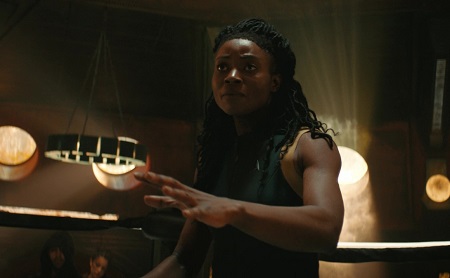
It’s all still to play for as we move into the final five episodes of the season. There are several key stories to find resolutions to: the DMA, Unknown Species 10-C, the Book-Burnham drama, and more. There’s also plenty of time, in five episodes, for Discovery to take off on a side-mission or two, as well as to introduce completely new and unexpected story elements. It’s even possible that Season 4 will end on a cliffhanger now that we know Season 5 is happening… so perhaps none of the big stories will be resolved until 2023. Say it ain’t so, Joe!
Before we go, one final point. I write up these theories because I like Star Trek and I like writing. But for some folks, fan theories can hamper their enjoyment of a film or television show. It’s worth keeping in mind that most of these theories probably won’t pan out, and we have to be prepared for the fact that even the most well-constructed fan theory, no matter how fun and plausible it seems, simply won’t turn out to be true. If you find that speculating and reading theories is beginning to detract from your enjoyment of Star Trek: Discovery – or any other television show or film – it might be a good idea to take a break for a while.
Star Trek: Discovery Season 4 is available to stream now on Paramount+ in the United States, Scandinavia, Latin America, and Australia. The show is on Pluto TV in the UK, France, Germany, Italy, and other parts of Western Europe at 9pm on Fridays and Saturdays. Individual episodes or the full season can be purchased on iTunes, Amazon Video, Google Play, and possibly other platforms in the UK, parts of Europe, and select other countries. The Star Trek franchise – including Discovery and all other properties mentioned above – is the copyright of ViacomCBS. This article contains the thoughts and opinions of one person only and is not intended to cause any offence.







